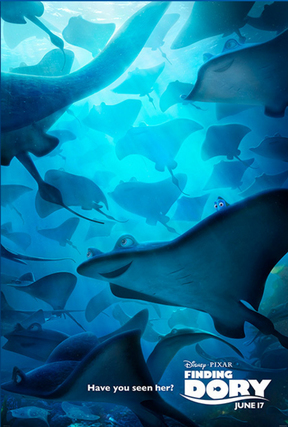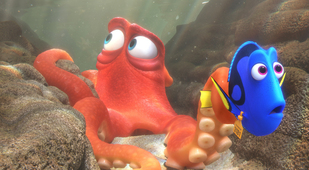Written by Mike Cervantes Since its re-inception in 1989, the Walt Disney Company has been good at exactly two things: one, is elevating a simple film concept like a family genre action film, or a family animated feature film to the status of a tear-jerking, action-packed, awe-inspired, just plain good ol’ time at the movies, with the first film in every such franchise sitting at the top of everyone’s “most favorite films” list. The other is taking said memorable, totally awesome film, and turning out a completely forgettable, uninspired, by-the-numbers, simple-plan factory-grade, sequel, usually starring the one-joke comic relief sidekick from that awe-inspiring flick. Even after four decades and a massive re-organization in 2000, the house that Eisner built, and Lasseter put a fresh coat of paint on, still has a nasty tendency to hold the pen of the muses in one hand, and the paddle they use to flog the dead horse in the other. That is not to say that every sequel that is made in this formula is particularly bad, provided you like Kronk from The Emperor’s New Groove more than The Lion King’s Timon and Pumbaa. And as long as you understand that, realistically, there’s no way that Johnny Depp could carry a whole Pirates of the Carribean all on his own. But for every minor success, there’s a cheap-direct-to-video, or worse, a Cars 2, to remind us that you can’t build the temple of a film franchise atop the back of Larry the Cable Guy. Which brings us to 2003’s Finding Nemo. Essentially, Pixar’s own personal cash cow in the vein of The Lion King, that one lightning-in-a-bottle success that has come to define the product of the company as a whole; the tear-jerking story of a father who worriedly dotes over his son in order to protect him from a terrible fate that already took his mother, only to have that son swept far across the ocean and land in an orthodontist’s fish tank. The comic relief in that film is provided by Ellen DeGeneres as Dory, a blue tang who takes outrageous risks despite literally having the memory of a goldfish. And while most people had fond memories of Dory in that role, I’ve always been rather on the fence with the character: Ellen DeGeneres is one of the most successful American stand-ups, a pillar of the LGBT community, and the head of a talk-show media empire that could elevate NBC/Universal to Disney’s status, if that is what she personally wanted. She exists in that movie as a Mister Magoo, just a character to break up the near constant tragedy of the plot, despite being obviously handicapped on her own. “Look at me, I’m dumb and that’s funny! Watch me magically move the plot forward!” is what she always seems to say. So Disney, in its invincible omniscience, decides to give us 90 minutes of Dorycentrism, and…It works. Really, I’ve never been so glad to be proven wrong! There was the opportunity to literally be led out to sea by this film, but the folks at Pixar have managed to fish into the subtle undertones and unanswered questions of one of its one-note comic sidekicks to breach the surface of watchability like a glorious plot-dolphin.  More than anything, the key to this film is the watcher’s own ability to remember. Sure, you can still enjoy this film without having first seen Finding Nemo, but recall of the first movie will help you get the most out of it. You might recall that Dory was looking for something she couldn’t remember when she first ran into Albert Brooks’ Marlon in the first movie. That “something” just happened to be her parents, who she had been searching for since childhood. After the lengthy detour that was the whole first movie, Dory has found a home in the coral reef next door to Marlon and Nemo (Hayden Rolence), but still feels like something is missing. Once the trio do one last call-back, hanging ten on the sea’s upper current with Crash (Andrew Stanton), the film takes a meaningful detour, and after some harsh words from Marlon, Dory wanders into a set of six-pack can rings and is scooped up by some humans in the Marine Life Institute, where the bulk of the film takes place. Probably the first thing you notice about the film as a whole is the perspective shift. We’re made to understand Dory as more than just a loose thread carrying a portable-plot hole because we’re constantly looking into her mind, seeing things the way she sees them, and therefore being with her whenever she seems to want to do something insane. This is a welcome change from the character in the first movie, though it leaves us bereft of those fan-favorite “he will be my squishy” moments that endeared her to so many. The other advantage is once she gets separated from the first film’s cast, she finds herself in a new playground with tons of fresh fish to interact with. The 7-legged, camouflaging, and land-walking octopus Hank, played gloriously by Modern Family’s Ed O’Neill, becomes the secondary protagonist. In some ways his character would go hand-in-hand, or fin-and-tentacle, with Marlon, but he has many different motivations that still keep him relevant on his own. His Modern Family co-star Ty Burrell plays Bayley, a captive beluga whale who’s slowly learning how to echolocate, and serves to aid Dory’s estranged friend Destiny (Kaitlyn Olson), a near-sighted whale shark who is keeping a constant vigil on her newly reunited friend. Other high points of the cast include Idris Elba and Dominic West as a pair of lazy but territorial sea lions, and of course Diane Keaton and Eugene Levy, who serve good purpose as Dory’s parents in multiple flashbacks. As Dory continues to backtrack into her past, we learn all about the empty plot-points she embodied in the first movie: why she speaks whale, why she sings “keep on swimming” when in doubt, and why she seems to love sand. More than anything, this movie exists to make Dory a fully fleshed out and realistic character, as opposed to the magical ditz of the first film. The overall message found in the story is also quite sound: we often worry about our disabled friends because they can’t do as much at us. But we should learn that they actually know how to be just as capable as we are, in their own way. While the film does actually sew in thematic elements from the original, and still can’t quite reach the high-notes that existed naturally in Finding Nemo, this film still manages to stay fresh, and does so by following its own lesson. Just keep swimming. There’s more to see and more to explore within this universe. You simply have to reach forward with your own experience in order to find it. Also, for the ultimate call-back joke, remember to stay all the way past the credits. Thank you.
0 Comments
Leave a Reply. |
Archives
March 2025
|
|
© 2012-2025, Nerds That Geek LLC.
All Rights Reserved. |
uWeb Hosting by FatCow


 RSS Feed
RSS Feed